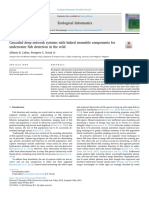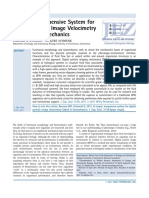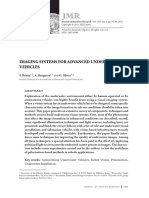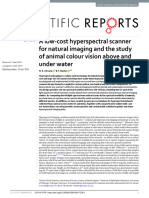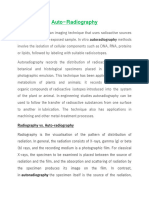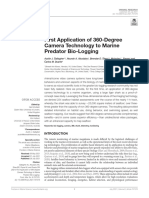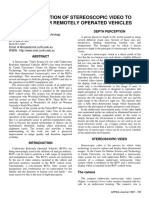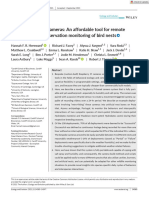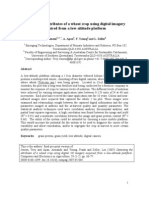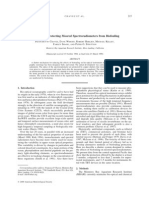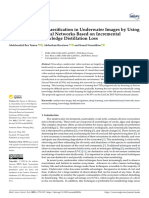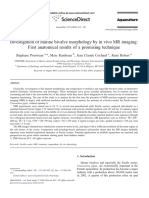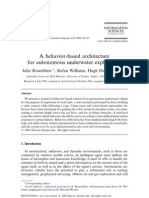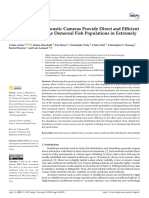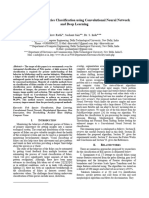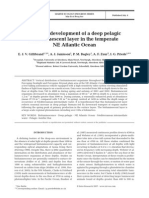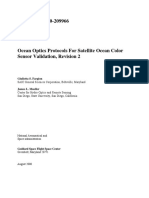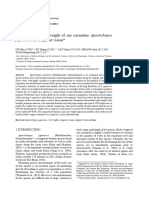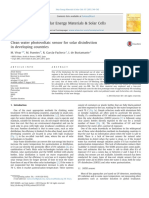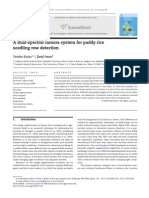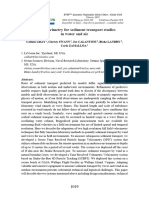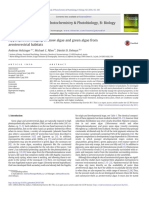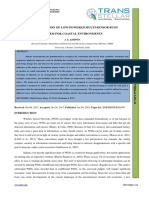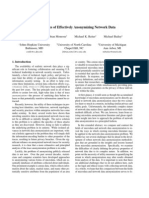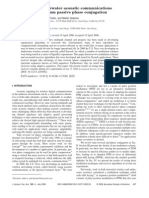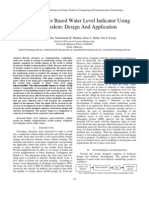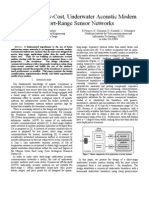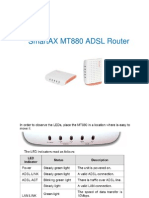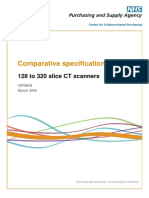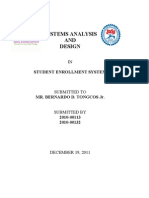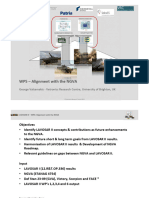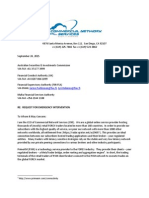0371
0371
Uploaded by
sebastienCopyright:
Available Formats
0371
0371
Uploaded by
sebastienCopyright
Available Formats
Share this document
Did you find this document useful?
Is this content inappropriate?
Copyright:
Available Formats
0371
0371
Uploaded by
sebastienCopyright:
Available Formats
LIMNOLOGY
and
OCEANOGRAPHY: METHODS
Limnol. Oceanogr.: Methods 5, 2007, 371378 2007, by the American Society of Limnology and Oceanography, Inc.
Underwater infrared video system for behavioral studies in lakes
Saad Chidami, Guillaume Gunard, and Marc Amyot*
Groupe de recherche interuniversitaire en limnologie (GRIL), Dpartement de sciences biologiques, Universit de Montral, succursale Centre Ville, CP 6128, Montreal, QC, H3C 3J7 Canada
Abstract
We propose the use of infrared (IR) video systems for the underwater behavioral study of animals at night, at depth, and/or in colored aquatic systems. This system is composed of a black-and-white video camera coupled with four projectors, each equipped with 50 IR light-emitting diodes (LEDs). The use of LEDs is energetically far more efficient than the use of halogen lights equipped with IR filters, and therefore allows automatic long-term video recording at low cost. Laboratory testing of one LED spot at increasing humic acid concentrations indicates that this system can be used for short-range underwater observation in colored lakes. We applied this system to the study of scavenger/carcass interactions. Under field conditions, the setup is not easily detected by animals and allows direct and continuous observation of animal interactions during a full daily cycle. Note that, to our knowledge, this video system provides the first published night movies of freshwater fish behavior filmed in highly colored lakes, without using visible light. Our results indicate that this nonintrusive system can be successfully used for scientific studies in freshwater ecology, even in the presence of significant concentrations of light-absorbing humic substances in the water.
Fish and large aquatic invertebrates are living in an environment that is difficult to access, and studies of these organisms is, therefore, challenging. Many techniques have been developed for the study of their growth, movement, reproductive, and feeding behavior. These include scientific fishing, hydroacoustics, photography, films, and direct visual observation by divers, tags, as well as combinations of the above (Trudel and Boisclair 1996; Thomas and Thorne 2001; Ermolchev and Zaferman 2003; Graham et al. 2004; Rose et al. 2005; Tessier et al. 2005). For behavioral studies, there is a particular value in obtaining visual data of inter- and intra-specific interactions. Observations by divers have been used for this purpose, but they do not allow post-diving image analyses and cannot be archived or re-examined for accuracy or reassessment (Harvey et al. 2002). In situ observations using underwater cameras are hampered by technical difficulties related to natural light penetration. This problem is particularly acute in lakes where light penetration and, hence, visibility is restricted (for example, by humic and fulvic acids). Moreover, as many aquatic organisms follow a diel pattern of activity, a full account of their activi-
*Corresponding author: m.amyot@umontreal.ca; tel.: 514-343-7496
Acknowledgments
This study was supported by a grant of the Collaborative Mercury Research Network (COMERN) and an NSERC grant to M.A.
ties would also require observations at night (Trudel and Boisclair 1996). Most studies using underwater visual observation with video systems have been performed in clear marine environments, coral reefs, and abyssal areas (Priede and Bagley 2000; Jones et al. 2003; Soltwedel et al. 2003; Trenkel et al. 2004; Tessier et al. 2005; Widder et al. 2005; Kemp et al. 2006; Priede et al. 2006). For shallow streams, camera mounted above the water column have also been used (Shardlow 2004). Some of these systems were equipped with cameras taking snapshots. Although these snapshots are useful for the detection and identification of fish, they cannot be efficiently used to record species interactions. Indeed, the study of fish movement and rapid interactions between organisms require fast image sampling (for example from 5 to 30 images per second). Sources of visible light have been used to obtain images and movies in dark conditions. However, visible light may repel or attract organism (Glass and Wardle 1989; Weinberg and Munro 1999; Kane et al. 2004; Trenkel et al. 2004; Marchesan et al. 2005; Widder et al. 2005) or create irreversible eye lesions (Herring et al. 1999). This may both raise an issue in conservation and alter the quality of the results. Infrared light sources and infrared sensitive cameras have been largely used in the laboratory (Batty 1983; Olla and Davis 1990; Widder 1992; Janssen et al. 1995; Link and Edsall 1996; Olla et al. 1998; Roberts and Anderson 2002; Fisher and Bellwood 2003), but not in the field. Widder et al. (2005) have successfully used
371
Chidami et al.
Underwater IR video system
red light for in situ observations in clear ocean waters. They concluded that although red light is detected by fish (contrarily to IR), it is less disruptive than white light. Recently, Mills et al (2005) provided the first published description of an underwater video IR system for marine behavioral studies. We propose the use of a custom-made, economical video system for the underwater behavioral study of freshwater animals. This system is equipped with an infrared (IR) light source that allows recording during night, at depth, and/or in colored aquatic systems. Our system does not emit red or white light, and thus this light is not detectable by aquatic animals. It allows direct and continuous observation of animal interactions during a complete daily cycle. The proposed system has been custom built for aquatic systems with high capacity for light absorption. It was initially designed to study the activity of scavengers feeding on fish carcasses at the bottom of lakes. This report first describes the system and evaluates its performance under controlled laboratory conditions. Then, we present an application of the system under field conditions, for the study of scavenger/carcass interactions in lakes.
Materials and procedures
Evaluation of IR spots in laboratoryTo evaluate the performance of the camera system in the dark, we built a projector using 55 monochromatic IR Light Emitting Diodes (LED, OP230WPS, Optek Technology) placed on a printed circuit board (PCB) (9 series of 5 LED connected to a 6.7 ohms resistor). The waveband emitted by these diodes (850 25 nm) is not detectable by fish, since they are unable to detect wavelengths higher than 700 nm (Govardovskii et al. 2000). This waveband is detected by a black and white underwater charge coupled device (CCD) video camera (SeaViewer, SeaDrop 550 series) equipped with a wide-angle lens (93 field of view). The camera is manufactured to detect IR up to a wavelength of 900 nm, as are most CCD cameras. The effectiveness of the system was tested in a 500-L Living Stream aquarium (model LSW Frigid Unit Inc.). The projector and the underwater video camera were installed facing a wooden plate, with two (10 5 cm. each) black and white rectangles used as targets. Note that the camera comes equipped with 6 LEDs that were found to be inadequate light sources under lake conditions. The wooden plate was placed at two distances (50 cm and 75 cm) from the camera system. To simulate underwater light conditions in lakes, we added a solution of humic acid (humic acid, sodium salt, tech., Acros organics) sequentially (from 0 to 3 mg L1 in steps of 0.5 mg L1). Pictures were collected using white illumination (2 40 W fluorescent lights). Lights were then turned off and the IR projector was used as source of illumination. Still images from the camera were digitized using a computer-based interface (ATI Technologies Inc. Radeon 7500), and analyzed using an image analyzer software (OsiriX, version 2.5.1). The ratio of the mean brightness of the white rectangle and the black rectangle was used as an index of the maximum
contrast obtainable in images. This procedure allowed us to evaluate the response of the system with or without visible light in conditions of increasingly colored water. Camera system used in lakeThe underwater video camera and IR projectors were mounted on a stainless steel frame (808070 cm) painted in brown to reduce detection by animals and to avoid overexposed area in the field of vision during daytime (Fig. 1). The camera was directed toward the bottom. The specific geometry of the light system was chosen to focus the beams on the carcasses under study while reducing to a minimum the IR light traveling distance. On the shore, three videotape recorders (programmed with videotapes of 8 h each) were connected to the camera to record fish activity over 24 h. Videotapes were changed every day. The system was powered by a parallel set of 4 deep cycle lead-acid batteries connected to a 12V DC to 110V AC converter. Batteries lasted for 5 d under this configuration. A black and white monitor was used to make sure that the system was operating properly (Fig. 1a). Four IR projectors, including 50 LED each (Fig. 1c, 1d), were enclosed individually in a custom-made underwater casing built with an acrylonitrile butadiene styrene (ABS) plastic cylinder and a Plexiglas window. The projectors were tested and permanently sealed with epoxy and ABS glue to avoid water infiltration. They were installed on the stainless steel frame and directed toward the center of the structure and the ground (Fig. 1b).
Fig. 1. (a) Diagram representing the different compounds and connections of the survey system. (b) Stainless steel frame mounted with the black and white camera (center-top), and the four custom-made IR spots on each corner. (c) Exploded view of an IR spot (from left to right): ABS casing and a PCB with LEDs (connected with an electric cable) between two supporting rings, and a Plexiglas window. (d) Electronic scheme of the PCB.
372
Chidami et al.
Underwater IR video system
CarcassesFish (average length: 30 cm) used as baits for the camera setup were Rainbow trout (Oncorhynchus mykiss). These fish were obtained from a nearby fishing center (Le martin pcheur, St-Adle, Quebec) and were killed by suffocation in a water basin. We avoided chemical products in order not to disturb the behavior of the scavengers during the observations. For each observation, one dead trout was laid on the bottom of the lake and the camera system placed over. To avoid displacements of the trout out of the field of view, the tail of the fish carcasses were attached to a weight using a monofilament fishing line. Study siteThree sampling sessions were carried out in Lake Cromwell (4559N, 7400W; area: 110 ha) during summer 2003, autumn of 2004, and summer 2005. This lake is located in the territory of the Station de biologie de lUniversit de Montral (80 km north of Montral, in the Lower Laurentian region of Quebec). Lake Cromwell is a shallow (mean depth: 3.6 m), humic lake (DOC: 8.9 mg L1) and holds populations of White suckers (Catostomus commersonni), Fallfish (Semotilus corporalis), Bluntnose minnows (Pimephales notatus), Rosyface shiners (Notropis rubellus), Redside shiners (Richardsonius balteatus), Brassy minnows (Hybognathus hankinsoni), Cutlips minnows (Exoglossum maxillingua). Those species are numerically dominated by Brown bullheads (Ictalurus nebulosus),
Pumpkinseed sunfish (Lepomis Gibbosus), and Northern redbelly dace (Phoxinus eos). The video system was installed at 1 m depth on the north shore, on a sediment area with a gentle slope. Because the littoral zones are grounds for fish feeding and spawning, they can be considered to be important natural mortality site (Elder and Smith 1988).
Assessments
Efficiency of IR lights in laboratoryWe quantified the sensitivity of a simplified version of the setup (with only one IR spot) in an aquarium amended with humic acids. The contrast (Fig. 2) obtained ranged from 1.01 to 1.46 (value of 1.0 means no contrast). Under laboratory light condition, at a distance of 50 cm, the contrast rapidly decreased with the addition of humic acid (from 1.46 at 0 mg L1 to 1.04 at 3 mg L1). At a distance of 75 cm, we observed a similar decrease in contrast (from 1.36 at 0 mg L1 to 1.02 at 3 mg L1). Since humic and fulvic acids only represent a fraction of total DOC (about 50%), the range of humic acids used here would translate into a larger range of DOC. Contrast obtained in dark conditions using IR illumination was lower at 50 cm (1.15 at 0 mg L1) than under laboratory light condition, but decreased at a lower rate with the addition of humic acid (1.08 at 3 mg L1). For concentrations of humic
Fig. 2. Contrast obtained for different type of illumination (white light and IR) for different concentration of humic acid and at different distances. Photos on the right side of the graph are taken at 50 cm from the target, in water containing 3 mg/L of humic acids, with A) white lights on, B) all lights off and C) one IR spot on.
373
Chidami et al.
Underwater IR video system
Fig. 3. Movie capture of an infrared on/off sequence at dusk. In A, the
IR spots are off and we can only see the dead trout (arrow 1). In B the infrared spots are on, a Brown bullhead (arrow 2) is eating the dead trout and near its head another brown bullhead appears (arrow 3).
acid over 2 mg L1, a better contrast was obtained with IR light than with lab lights. At a distance of 75 cm, the contrast was low (average: 1.01), and it was difficult to discern the different targets. We considered that the images obtained at 75 cm were at the detection limit of the IR system used at the laboratory. This preliminary evaluation demonstrated that infrared radiation can be used reliably to obtain underwater images, even in highly humic conditions, but is limited to close range, likely because of the absorption of IR by water. White light allowed better contrast, but is more affected by the addition of humic acid. To achieve a better contrast at higher distances, we increased IR illumination by using a system incorporating 4 IR projectors. This upgraded system was used in the field. Movies showing the level of resolution obtained under dark conditions (at night) are available in the Appendix (Movie 1: sequence when the spots are turned on; Movie 2: sequence showing scavenger/carcass interaction). Note that the actual
videotape provides a higher resolution then the digitized, compressed file (a full resolution digitized file would have been too large for downloads). Attraction or repulsive effect of the structure and the infrared floodlightsAs hypothesized by Widder et al. (2005), fish may react instantly upon detection of a sudden burst of light. We verified this assumption by turning the IR lights on and off several times (5 to 6 times), and for periods of different duration (1 s to 30 s) at dusk. The film was observed for evidence of noticeable fish behavior change (escape, aggregation, etc.) as the IR light was turned on and off. No notable effect on fish behavior was observed (Fig. 3). A movie showing the lack of response of scavengers to the IR spots is available in the Appendix (Movie 3). We quantified the reactivity of fish toward the structure and the bait by determining the number of fish present in the field of vision (FOV) of the camera, the time spent in the FOV, and the possible interaction with the structure or the carcass (Fig. 4). Just after the deposition of the structure and in the absence of bait, it took 7 min for the first fish to appear in the FOV (Fig. 4, Panel I). During the first 30 min of the experiment, an average of 0.77 fish min1 passed through the FOV. In the absence of carcasses, the video system recorded no direct interaction between incoming fish and the structure at day or night, and fish typically stayed less than 20 s in the field of vision (Fig. 4, panels I and III). When a carcass was placed under the structure, approximately 50% of incoming fish interacted directly and rapidly with the carcass, and the attendance time in the field of vision increased to up to 75 s (Fig. 4, panel II). Note that the scales for the different panels differ. An average of 4.4 fish min1 passed through the FOV, i.e., about 5.7 times more than in the
Fig. 4. Top panel: Attendance time (seconds) of fish in the field of vision (FOV). Bottom panel: time of interaction (seconds) of the scavengers with the structure or the carcass of the rainbow trout. This setup was installed in Lake Cromwell at 1 m depth (22 and 23 June 2005).
374
Chidami et al.
Underwater IR video system
Fig. 5. Left panels: Density of scavengers in the FOV for different dates in Lake Cromwell at 1 m depth. The density was measured every 5 min. Right
panels: interactions between scavenger species and a fish carcass at 5 min intervals. The gray bar (at 300 s) represents the 5 min limit. The horizontal bar below the X axis codes for night time (black bar), day time (white bar), and dawn/dusk periods (gray bar).
absence of fish. We conclude that the structure did not attract or repulse fish significantly when compared with carcasses. Application of the system to the study of scavenger/carcass interactionsWe analyzed the videotapes to identify fish scavengers and to assess the level of their interaction with the bait. We first establish the presence of fish species and number of individuals per species in the FOV, using a movie frame (i.e., a still image) taken every 5 min (Fig. 5; left panels). We then analyzed all movie frames to quantify the activity of scavengers around the dead fish. The level of activity was calculated as the total duration of interaction (seconds of biting or eating) of each scavenger species with the bait on periods of 5 min (Fig. 5; right panels). These results indicate that we can successfully track the day and night scavenging behavior of fish with a high temporal resolution. A comparison of all the resulting time series for the different seasons, fish species, and period of the day (day and night) was also made (Fig. 6). Only three fish species acted as scav-
engers: pumpkinseed sunfish (Lepomis gibbosus), brown bullhead (Ictalurus nebulosis), and the creek chub (Semotilus atromaculatus). The left panels, which only report fish presence, represent the information typically obtained by photographic approaches. Right panels show the full potential of the camera system and allow to clearly identify scavengers and their level of activity. Indeed, it is the capacity to perform continuous observation without disruption that is critical for the interaction assessment. It allows the discrimination between actors and spectators. We examined seasonal changes in the presence and necrophagous activity of fish during the day (Fig. 6A and 6B). For both summer and fall, creek chubs were the most commonly observed (Fig. 6A) and the most active (Fig. 6B) fish species, with an average of 3 (fall) and 5 (summer) individuals present at the same time in the FOV. The mean scavenging activity of creek chubs ranged from 890 s h1 (summer) to 1080 s h1
375
Chidami et al.
Underwater IR video system
Fig. 6. Left panels: Mean density of scavengers in the FOV (A) for two seasons during the day and (C) for day versus night, during autumn. The density was measured every 5 min and averaged over 1 h. Right panels: interactions of scavengers with the carcass (B) for two seasons during the day and (C) for day versus night, during autumn.
(fall). Pumpkinseeds were also present in significant numbers during summer time (1.5 individual; Fig. 6A), but few interactions were observed with the carcass (30 s h1; Fig. 6B). During fall, Pumpkinseeds were virtually absent and inactive. Brown bullheads were rarely observed during daytime (average: 0.2 individuals during fall and 0.3 during summer). Changes in activity of scavengers between night and day were assessed during a fall mission (Fig. 6 C and D). At night, we observed about the same number of creek chubs (1.1 ind.; Fig. 5C) and brown bullhead (1.05 ind.) swimming around the carcass, but the brown bullheads was more actively scavenging (1300 s h1; Fig. 5D) than creek chubs (290 s h1). Pumpkinseeds were present in the FOV, but were not directly interacting with the carcass. Nevertheless, they were observed snatching little debris of flesh left by the other scavengers. During daytime, a species switch occurred, with creek chubs being more numerous (2.9 ind.) and active (1180 s h1) than brown bullhead (0.2 ind.; 80 s h1).
Discussion and comments
This setup combines an infrared system and a video camera and yields interesting results in stealth and data acquisition regarding animal behavior in colored systems. The technique
does not have a notable impact on fish behavior. The image resolution is sufficient to allow: (1) the identification of aquatic vertebrates in a highly colored lake (Lake Cromwell; DOC: 8.9 mg/L) during day and night and (2) the description of animal interactions at high temporal resolution. This approach can be applied at low cost (material cost around 2000 US$). To obtain good recording during nighttime, the system must incorporate a large number of LED (around 200 in our study) to overcome the absorption of IR by water. One LED consumes a small amount of energy (200 mW), yet efficiently converts electricity to light (50%) when compared with a halogen bulb light (9% overall efficiency; even less if an IR pass filter is used). To enhance the efficiency, increase light output, and avoid overheating of the IR LED, a pulse-driving system with variable frequencies can be incorporated to the projector. The frequency of such projector has to be set in phase with the shutter frequency of the camera. The use of infrared LED seems the most suitable approach to obtain stealth underwater recordings with a reasonable supply of electrical power. This system can be easily adapted to meet the requirements of a specific study. Future users should select a high-sensitivity camera over a high-resolution one. Indeed, the sensitivity of
376
Chidami et al.
Underwater IR video system
the camera should ideally peak around the wavelength emitted by the IR LED selected to build the projectors. Because of rapid IR absorption by water, the geometry of the setup should be designed to limit the distance traveled by the IR light, whereas providing a sufficient FOV to answer the question of interest. Projectors can be added near the camera to illuminate the water volume between the target and the camera. Also, processing of video images could be greatly simplified by the use of a complete digital set-up (i.e., by replacing VHS recorders with digital storage devices, such as hard drives). C++ software can easily be developed to detect animal movements on the videos (e.g., using Intel opencv open source library). This study presents the first published video system able to record underwater night behavior of fish in colored freshwater systems at very low cost. It provides a new way to test scientific hypotheses regarding, for instance, fish territoriality, fish behavior during nesting, and scavenger/fish interactions. By installing two cameras to obtain a three-dimensional representation of animal movement, the setup can also be used to assess animal bioenergetics at night, a recognized gap of knowledge in fish studies (Trudel and Boisclair 1996).
References
Batty, R. S. 1983. Observation of fish larvae in the dark with television and infrared illumination. Mar. Biol. 76:105-107. Elder, R. L., and G. R. Smith. 1988. Fish taphonomy and environmental inference in paleolimnology. Palaeogeogr. Palaeoclimatol. Palaeoecol. 62:577-592. Ermolchev, V. A., and M. L. Zaferman. 2003. Results of experiments on the video-acoustic estimation of fish target strength in situ. ICES J. Mar. Sci. 60:544-547. Fisher, R., and D. R. Bellwood. 2003. Undisturbed swimming behaviour and nocturnal activity of coral reef fish larvae. Mar. Ecol. Prog. Ser. 263:177-188. Glass, C. W., and C. S. Wardle. 1989. Comparison of the reactions of fish to a trawl gear, at high and low light intensities. Fish. Res. 7:249-266. Govardovskii, V. I., N. Fyhrquist, T. Reuter, D. G. Kuzmin, and K. Donner. 2000. In search of the visual pigment template. Visual Neurosci. 17:509-528. Graham, N., E. G. Jones, and D. G. Reid. 2004. Review of technological advances for the study of fish behaviour in relation to demersal fishing trawls. ICES J. Mar. Sci. 61:1036-1043. Harvey, E., D. Fletcher, and M. Shortis. 2002. Estimation of reef fish length by divers and by stereo-videoA first comparison of the accuracy and precision in the field on living fish under operational conditions. Fish. Res. 57:255-265. Herring, P. J., E. Gaten, and P. M. J. Shelton. 1999. Are vent shrimps blinded by science? Nature 398:116. Janssen, J., W. R. Jones, A. Whang, and P. E. Oshel. 1995. Use of the lateral-line in particulate feeding in the dark by juvenile alewife (Alosa-Pseudoharengus). Can. J. Fish. Aq. Sci. 52:358-363. Jones, E. G., A. Tselepides, P. M. Bagley, M. A. Collins, and I. G.
Priede. 2003. Bathymetric distribution of some benthic and benthopelagic species attracted to baited cameras and traps in the deep eastern Mediterranean. Mar. Ecol. Progr. Ser. 251:75-86. Kane, A. S., J. D. Salierno, G. T. Gipson, T. C. A. Molteno, and C. Hunter. 2004. A video-based movement analysis system to quantify behavioral stress responses of fish. Water Res. 38:3993-4001. Kemp, K. M., and others. 2006. Consumption of large bathyal food fall, a six-month study in the NE Atlantic. Mar. Ecol. Progr. Ser. 310:65-76. Link, J., and T. A. Edsall. 1996. The effect of light on Lake Herring (Coregonus artedi) reactive volume. Hydrobiologia 332:131-140. Marchesan, M., M. Spoto, L. Verginella, and E. A. Ferrero. 2005. Behavioural effects of artificial light on fish species of commercial interest. Fish. Res. 73:171-185. Mills, D. J., G. Verdouw, and S. D. Frusher. 2005. Remote multi-camera system for in situ observations of behaviour and predator/prey interactions of marine benthic macrofauna. N. Z. J. Mar. Freshw. Res. 39:347-352. Olla, B. L., and M. W. Davis. 1990. Effects of physical factors on the vertical-distribution of larval Walleye Pollock Theragra-Chalcogramma under controlled laboratory conditions. Mar. Ecol. Progr. Ser. 63:105-112. , M. W. Davis, and C. B. Schreck. 1998. Temperature magnified postcapture mortality in adult sablefish after simulated trawling. J. Fish Biol. 53:743-751. Priede, I. G., and P. M. Bagley. 2000. In situ studies on deepsea demersal fishes using autonomous unmanned lander platforms, p. 357-392. Oceanography and Marine Biology, Vol 38. Taylor & Francis. and others. 2006. The absence of sharks from abyssal regions of the worlds oceans. Proc. Royal Soc. B-Biol. Sci. 273:1435-1441. Roberts, J. M., and R. M. Anderson. 2002. A new laboratory method for monitoring deep-water coral polyp behaviour. Hydrobiologia 471:143-148. Rose, C. S., A. W. Stoner, and K. Matteson. 2005. Use of highfrequency imaging sonar to observe fish behaviour near baited fishing gears. Fish. Res. 76:291-304. Shardlow, T. 2004. Using time-lapsed video to estimate survey life for area-under-the-curve methods of escapement estimation. N. Am. J. Fish. Manage. 24:1413-1420. Soltwedel, T., K. Von Juterzenka, K. Premke, and M. Klages. 2003. What a lucky shot! Photographic evidence for a medium-sized natural food-fall at the deep seafloor. Oceanolog. Acta 26:623-628. Tessier, E., P. Chabanet, K. Pothin, M. Soria, and G. Lasserre. 2005. Visual censuses of tropical fish aggregations on artificial reefs: slate versus video recording techniques. J. Exp. Mar. Biol. Ecol. 315:17-30. Thomas, G. L., and R. E. Thorne. 2001. Night-time predation by Steller sea lions. Nature 411:1013.
377
Chidami et al.
Underwater IR video system
Trenkel, V. M., P. Lorance, and S. Mahevas. 2004. Do visual transects provide true population density estimates for deepwater fish? ICES J. Mar. Sci. 61:1050-1056. Trudel, M., and D. Boisclair. 1996. Estimation of fish activity costs using underwater video cameras. J. Fish Biol. 48: 40-53. Weinberg, K. L., and P. T. Munro. 1999. The effect of artificial light on escapement beneath a survey trawl. ICES J. Mar. Sci. 56:266-274.
Widder, E. A. 1992. Mixed light imaging-system for recording bioluminescence behaviors. J. Mar. Biol. Assoc. U. K. 72: 131-138. , B. H. Robison, K. R. Reisenbichler, and S. H. D. Haddock. 2005. Using red light for in situ observations of deep-sea fishes. Deep-Sea Res. I-Oceanogr. Res. Papers 52:2077-2085.
Submitted 25 October 2006 Revised 4 August 2007 Accepted 31 August 2007
378
You might also like
- Template Sample Paper - CS435Document9 pagesTemplate Sample Paper - CS435المائدہ100% (3)
- German Phrases Auf Deutsch v2Document31 pagesGerman Phrases Auf Deutsch v2Kashif Anwer100% (5)
- Documentatie Card Payment MobilPayDocument11 pagesDocumentatie Card Payment MobilPayOvidiu AlexNo ratings yet
- Biomimetic Nanotechnology: Why Move Into The Nanoworld?Document28 pagesBiomimetic Nanotechnology: Why Move Into The Nanoworld?rkppkNo ratings yet
- FSZ 025Document13 pagesFSZ 025jagtapdevkinandan60No ratings yet
- 10.1016@j.ecoinf.2019.05.004Document19 pages10.1016@j.ecoinf.2019.05.004irilNo ratings yet
- Ryerson and Schwenk 2011 - PIV MethodDocument14 pagesRyerson and Schwenk 2011 - PIV MethodHua Hidari YangNo ratings yet
- jaja,+Journal+manager,+146-317-1-CEDocument22 pagesjaja,+Journal+manager,+146-317-1-CEwilcoxon007No ratings yet
- Automatic Coral Detection With YOLO: A Deep Learning Approach For Efficient and Accurate Coral Reef MonitoringDocument7 pagesAutomatic Coral Detection With YOLO: A Deep Learning Approach For Efficient and Accurate Coral Reef Monitoringk.buyankinaNo ratings yet
- Sensors 20 00726 With CoverDocument26 pagesSensors 20 00726 With CoverNaveed CheemaNo ratings yet
- (Nev19) A Low-Cost Hyperspectral Scanner For Natural Imaging and The Study of Animal Colour Vision Above and Under WatDocument14 pages(Nev19) A Low-Cost Hyperspectral Scanner For Natural Imaging and The Study of Animal Colour Vision Above and Under Wathassanheza7No ratings yet
- Equipment Based On High Power Uv and White Light Leds To Collect and Observe Scorpions (Arachnida: Scorpiones) and Other Fluorescent OrganismsDocument4 pagesEquipment Based On High Power Uv and White Light Leds To Collect and Observe Scorpions (Arachnida: Scorpiones) and Other Fluorescent OrganismsPawan KumarNo ratings yet
- journal.pone.0263377Document23 pagesjournal.pone.0263377WafaNo ratings yet
- 73 6th Sem DSE4 UNIT 3 Autoradiography-Converted - Chandan Kumar AcharayaDocument4 pages73 6th Sem DSE4 UNIT 3 Autoradiography-Converted - Chandan Kumar Acharayathakurak110304No ratings yet
- MGET Overview November 2013Document40 pagesMGET Overview November 2013udawahidinNo ratings yet
- First Application of 360-Degree Camera Technology To Marine Predator Bio-LoggingDocument7 pagesFirst Application of 360-Degree Camera Technology To Marine Predator Bio-LoggingDavid SandersNo ratings yet
- Automated Molting Detection System For Commercial Soft-Shell Crab (Portunus Pelagicus) ProductionDocument9 pagesAutomated Molting Detection System For Commercial Soft-Shell Crab (Portunus Pelagicus) ProductionjimNo ratings yet
- Animals 12 01976 v2Document16 pagesAnimals 12 01976 v2JPNo ratings yet
- Neutron RadiographyDocument5 pagesNeutron RadiographyMohammed Al-leswasNo ratings yet
- Xue 2011Document7 pagesXue 2011nguyen.songtung9xNo ratings yet
- Auto RadiographyDocument3 pagesAuto RadiographyShushovan Usha BanikNo ratings yet
- Evaluating Disinfection Performance of Ultraviolet Light Emitting 2022 ChemDocument9 pagesEvaluating Disinfection Performance of Ultraviolet Light Emitting 2022 ChemAbigailNo ratings yet
- The Application of Stereoscopic Video To Underwater Remotely Operated VehiclesDocument4 pagesThe Application of Stereoscopic Video To Underwater Remotely Operated VehiclesMariannaNo ratings yet
- 1Document9 pages1Ahana RoyNo ratings yet
- Ecology and Evolution - 2021 - Hereward - Raspberry Pi nest cameras An affordable tool for remote behavioral andDocument13 pagesEcology and Evolution - 2021 - Hereward - Raspberry Pi nest cameras An affordable tool for remote behavioral andricardoloureirosoareNo ratings yet
- Jensen Apan Young Zeller 2007authorversion PDFDocument18 pagesJensen Apan Young Zeller 2007authorversion PDFFernando LunaNo ratings yet
- Chavez Copper ShutterDocument5 pagesChavez Copper ShutterususususuNo ratings yet
- Limnology Ocean Methods - 2014 - Kannappan - Identifying Sea Scallops From Benthic Camera ImagesDocument14 pagesLimnology Ocean Methods - 2014 - Kannappan - Identifying Sea Scallops From Benthic Camera ImagesSagte_SaidNo ratings yet
- Technical Proposal 1Document8 pagesTechnical Proposal 1Rahul kundiyaNo ratings yet
- Monoraphid and Naviculoid Diatoms from the Coastal Laurentian Great LakesFrom EverandMonoraphid and Naviculoid Diatoms from the Coastal Laurentian Great LakesAndrzej WitkowskiNo ratings yet
- Live Fish Species Classification in Underwater ImaDocument15 pagesLive Fish Species Classification in Underwater Imaabourifa hananeNo ratings yet
- Investigation of Marine Bivalve Morphology by in Vivo MR Imaging: First Anatomical Results of A Promising TechniqueDocument9 pagesInvestigation of Marine Bivalve Morphology by in Vivo MR Imaging: First Anatomical Results of A Promising TechniqueGabo HurtadoNo ratings yet
- A Behavior-Based ArchitectureDocument19 pagesA Behavior-Based Architecture9777907190No ratings yet
- applsci-11-01899-v2Document16 pagesapplsci-11-01899-v2WafaNo ratings yet
- pdf1805 10106 PDFDocument6 pagespdf1805 10106 PDFMinHaz NiloyNo ratings yet
- Gillibrand Et Al. (2007) - Seasonal Development of A Deep Pelagic Bio Luminescent Layer in The Temperate NE Atlantic OceanDocument8 pagesGillibrand Et Al. (2007) - Seasonal Development of A Deep Pelagic Bio Luminescent Layer in The Temperate NE Atlantic OceanTJNZNo ratings yet
- Mitchell Et Al 2000Document30 pagesMitchell Et Al 2000AbrahamNo ratings yet
- Deep-Sea Research II: Xabier Guinda, Ana Gracia, Araceli Puente, José Antonio Juanes, Yuri Rzhanov, Larry MayerDocument9 pagesDeep-Sea Research II: Xabier Guinda, Ana Gracia, Araceli Puente, José Antonio Juanes, Yuri Rzhanov, Larry MayerLarry Mayer UNHNo ratings yet
- Evaluation of Body Weight of Sea Cucumber Apostichopus Japonicus by Computer VisionDocument7 pagesEvaluation of Body Weight of Sea Cucumber Apostichopus Japonicus by Computer VisionSagte_SaidNo ratings yet
- 4 Scias48 614Document9 pages4 Scias48 614leedarsh25No ratings yet
- HYDRA: High Yield Data Recording Acoustic Array: L.Troiano, R.Dymond, A.Dassatti, C.Olivero, P.Guerrini, A.MaguerDocument8 pagesHYDRA: High Yield Data Recording Acoustic Array: L.Troiano, R.Dymond, A.Dassatti, C.Olivero, P.Guerrini, A.MaguerCarlos de ObladiaNo ratings yet
- Ijg 2020103015151693Document21 pagesIjg 2020103015151693Wi EmNo ratings yet
- Heavy Metal Toxicity in Fishes of Polluted Lakes of Dhaka City and Its Impacts On Human HealthDocument9 pagesHeavy Metal Toxicity in Fishes of Polluted Lakes of Dhaka City and Its Impacts On Human HealthalphabdNo ratings yet
- Solar Energy Materials & Solar Cells: M. Vivar, M. Fuentes, R. García-Pacheco, I. de BustamanteDocument15 pagesSolar Energy Materials & Solar Cells: M. Vivar, M. Fuentes, R. García-Pacheco, I. de BustamanteRezwana SarwarNo ratings yet
- OSL PaperDocument9 pagesOSL PaperHarpreet sainiNo ratings yet
- Aquatic Environment Monitoring Using A Drone Based FluorosensorDocument8 pagesAquatic Environment Monitoring Using A Drone Based Fluorosensorito300No ratings yet
- Pedersen Detection of Marine Animals in A New Underwater Dataset With CVPRW 2019 PaperDocument9 pagesPedersen Detection of Marine Animals in A New Underwater Dataset With CVPRW 2019 Papermahalekshmi anilNo ratings yet
- Null 2Document24 pagesNull 2Muhammad FaizanNo ratings yet
- López-Polín, L. Et Al. Láser Removing Carbonated Matrices From Fossils. 2008Document8 pagesLópez-Polín, L. Et Al. Láser Removing Carbonated Matrices From Fossils. 2008Trinidad Pasíes Arqueología-ConservaciónNo ratings yet
- A Dual-Spectral Camera System For Paddy Rice Seedling Row DetectionDocument8 pagesA Dual-Spectral Camera System For Paddy Rice Seedling Row DetectionAhmyd MuslymNo ratings yet
- 17 102 GrayDocument18 pages17 102 GrayBasem MohamedNo ratings yet
- Near-Infrared (NIR) - Reflectance in InsectsDocument33 pagesNear-Infrared (NIR) - Reflectance in InsectstaanjitNo ratings yet
- 1 s2.0 S0025326X20301442 MainDocument16 pages1 s2.0 S0025326X20301442 MainBagus Tri AtmojoNo ratings yet
- Journal of Photochemistry & Photobiology, B: Biology: Andreas Holzinger, Michael C. Allen, Dimitri D. DeheynDocument9 pagesJournal of Photochemistry & Photobiology, B: Biology: Andreas Holzinger, Michael C. Allen, Dimitri D. DeheynRaka Putra NugrahaNo ratings yet
- Radiography & Surgery - SA & LADocument80 pagesRadiography & Surgery - SA & LAMelrose Del Pilar CondinoNo ratings yet
- BOMBER A Tool For Estimating Water Quali PDFDocument6 pagesBOMBER A Tool For Estimating Water Quali PDFaubrey mae VargasNo ratings yet
- Manuscript Preprint JASA 05739Document40 pagesManuscript Preprint JASA 05739honiwi3818No ratings yet
- Bongiorno2017 FILA 71Document18 pagesBongiorno2017 FILA 71Angel RamosNo ratings yet
- Image Receptors - For Dental Radiology SeminarDocument67 pagesImage Receptors - For Dental Radiology SeminarPuneet Choudhary50% (2)
- Underwater Objects Detection and Tracking Using Image ProcessingDocument9 pagesUnderwater Objects Detection and Tracking Using Image ProcessingSyedaNo ratings yet
- Implementation of Low-Powered Multi-Sensor Buoy System For Coastal EnvironmentsDocument6 pagesImplementation of Low-Powered Multi-Sensor Buoy System For Coastal EnvironmentsTJPRC PublicationsNo ratings yet
- Applications of Radiations.Document5 pagesApplications of Radiations.Adia ChatthaNo ratings yet
- Exploring Time Series of Hyperspectral Images ForDocument19 pagesExploring Time Series of Hyperspectral Images ForDharmi JaviyaNo ratings yet
- Cisco Exploration CCNA 4.0 - CCNA 1 Final Exam Answers 2011Document11 pagesCisco Exploration CCNA 4.0 - CCNA 1 Final Exam Answers 2011Saurav AgunNo ratings yet
- CNSSNewDocument514 pagesCNSSNewsebastienNo ratings yet
- Content: Answers For The 2nd Quiz in Atelier Audio VisuelDocument1 pageContent: Answers For The 2nd Quiz in Atelier Audio VisuelsebastienNo ratings yet
- Jing Zhou: Personal RecordDocument6 pagesJing Zhou: Personal RecordsebastienNo ratings yet
- Answers For The 1st Quiz in Atelier Audio Visuel (2012)Document1 pageAnswers For The 1st Quiz in Atelier Audio Visuel (2012)sebastienNo ratings yet
- PIC16F8X: 8-Bit CMOS Flash/EEPROM MicrocontrollersDocument122 pagesPIC16F8X: 8-Bit CMOS Flash/EEPROM MicrocontrollerssebastienNo ratings yet
- Micro TPDocument7 pagesMicro TPsebastienNo ratings yet
- Parate 08 Trace PubDocument20 pagesParate 08 Trace PubsebastienNo ratings yet
- Compact Hilbert Indices For Multi-Dimensional DataDocument8 pagesCompact Hilbert Indices For Multi-Dimensional DatasebastienNo ratings yet
- Article 1 - Catch09 - Anonymizing - FinalDocument7 pagesArticle 1 - Catch09 - Anonymizing - FinalsebastienNo ratings yet
- Point-To-Point Underwater Acoustic Communications Using Spread-Spectrum Passive Phase ConjugationDocument11 pagesPoint-To-Point Underwater Acoustic Communications Using Spread-Spectrum Passive Phase ConjugationsebastienNo ratings yet
- Microcontroller Based Water Level Indicator Using GSM Modem: Design and ApplicationDocument5 pagesMicrocontroller Based Water Level Indicator Using GSM Modem: Design and ApplicationsebastienNo ratings yet
- Oceans10-Low Cost ModemDocument9 pagesOceans10-Low Cost ModemsebastienNo ratings yet
- HUAWEIDocument14 pagesHUAWEIsebastienNo ratings yet
- SN P3Document5 pagesSN P3Jan GullmanNo ratings yet
- CT Scanners ComparisonDocument61 pagesCT Scanners Comparisonsamql91GNo ratings yet
- Introduction To Big Data AnalyticsDocument33 pagesIntroduction To Big Data AnalyticsTrần Nguyên Thái BảoNo ratings yet
- Heroes of Might and Magic 5 Cheats, Codes, Cheat Codes, Walkthrough, Guide, FAQDocument6 pagesHeroes of Might and Magic 5 Cheats, Codes, Cheat Codes, Walkthrough, Guide, FAQNumpangNampangNo ratings yet
- Java Lab RecordDocument17 pagesJava Lab RecordAbhilash AbhiNo ratings yet
- ISM - CP - 7-7-2022 MPSTME Course OutlineDocument10 pagesISM - CP - 7-7-2022 MPSTME Course OutlineEshan JainNo ratings yet
- Cisco Autonomous AP Dot1x Avaya 3631Document10 pagesCisco Autonomous AP Dot1x Avaya 3631aliveli85No ratings yet
- Systems Analysis AND Design: Student Enrollment SystemDocument10 pagesSystems Analysis AND Design: Student Enrollment SystemImee JavierNo ratings yet
- SAP Record Management AuthorizationsDocument8 pagesSAP Record Management AuthorizationsJoe Malema100% (1)
- 2015 07 09 Workshop 2 Lavosar II - 6 wp5Document14 pages2015 07 09 Workshop 2 Lavosar II - 6 wp5skr2010No ratings yet
- EggnoidDocument11 pagesEggnoidApriani SimbiNo ratings yet
- PGP Cloud Computing BrochureDocument19 pagesPGP Cloud Computing BrochureNandish NNo ratings yet
- Mobile Computing: Intents, Intent-FiltersDocument21 pagesMobile Computing: Intents, Intent-Filtersdolby3dNo ratings yet
- Teradyne Corporation: The Jaguar Project.Document11 pagesTeradyne Corporation: The Jaguar Project.Tonya Somerton100% (3)
- Tata DocomoDocument39 pagesTata Docomoibcs16No ratings yet
- Request For Emergency InterventionDocument3 pagesRequest For Emergency InterventionTorVikNo ratings yet
- CE Syllabus Primer Soil MechanicsDocument7 pagesCE Syllabus Primer Soil MechanicsHatsuieeNo ratings yet
- 3D Printed AntennaDocument11 pages3D Printed AntennaGanga PandeyNo ratings yet
- WelcomeDocument23 pagesWelcomeabiramanNo ratings yet
- PP Hana Dumbs Prithiv SeshayaDocument121 pagesPP Hana Dumbs Prithiv SeshayaAmirtham AlexNo ratings yet
- Lowell Fryman USGS 2017 FinalDocument18 pagesLowell Fryman USGS 2017 FinalNathanael LieNo ratings yet
- Role of Social Media in Our LifeDocument29 pagesRole of Social Media in Our LifeDiana WilliamsNo ratings yet
- INDUCTIVE REACTANCE CS LabDocument22 pagesINDUCTIVE REACTANCE CS LabNoor Ul HaqNo ratings yet
- Upgrading NCC 8000 To NCC Windows DN1567-0405Document2 pagesUpgrading NCC 8000 To NCC Windows DN1567-0405Fiaz BaloochNo ratings yet
- Red Cross Evaluation ReportDocument52 pagesRed Cross Evaluation ReportRachel YeeNo ratings yet
- Autosys User GuideDocument508 pagesAutosys User GuideajaymalaniNo ratings yet
- Idl Simple ManualDocument16 pagesIdl Simple ManualpradeepkgkNo ratings yet





